| See Media |
| Autographed document addressed to Isaac Scidmore and signed by (Ezra) L'Hommedieu (1734 - 1811), a delegate to New York in the Continental Congress from 1779-83 and 1788. Dated March 29, 1757. Dimensions: 1 page; 18.5 x 19.5 cm. Acquired from Alexander Autographs in November 2008. Processed by Kristen J. Nyitray, Head of Special Collections and University Archives in February 2009. Historical Context |
| In this early legal document, Isaac Scidmore has been ordered to appear in the Suffolk County Hall, on October 2, 1757 and to bring with him his grandfather John Scidmore's will and the deeds to a property in order to settle a dispute. A fine of 100 pounds will be levied against him if he fails to appear. The term "per curiam" is written near the end of the document. A per curiam decision is a delivered via an opinion issued in the name of the Court rather than specific justices. Ezra L'Hommedieu (1734-1811) was born in Southold, Long Island, New York. Born into a Long Island family of Dutch and French Huguenot ancestry, he practiced law in New York City after his graduation from Yale in 1754. L'Hommedieu was a noted patriot of the Revolutionary War era and represented New York in the Continental Congress during the years 1779-87 and 1788. He also served in the State Assembly as a senator and other local offices, and was an author of the New York State Constitution. He helped to design the lighthouse at Montauk Point, a project on which he advised George Washington and also developed methods of scientific farming, including the use of ground seashells to fertilize soils. Ezra L'Hommedieu served as clerk of Suffolk County from January 1784 to March 1810 and from March 1811 until his death. He is buried in the Presbyterian Church Cemetery in Southold near the grave of his first wife, the former Charity Floyd, whose brother was General William Floyd, a signer of the Declaration of Independence. Transcription "By virtue of a supena to you directed and here with shown unto you, all businesses and expenses whatsoever laid aside you are personally to be and appear at the County Hall in and for the County of Suffolk on Tuesday the second day of October ? and bring along with you your Grand father John Scidmores original will and also three deeds one from Cornelius Conklin to John Scidmore another from William Jarvis, John Mott and John Titus. The other from John Whitman to said John Scidmore And this you will not omitt (sic) or paid of one hundred pounds." To Isaac Scidmore Dated 29 March 1757 Per curiam L'Hommedieu Clerk |
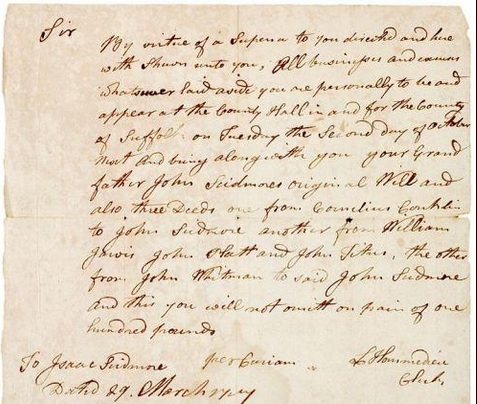
| 1772, Long Island, New York, purchase of slave girl, Abigail This is an original document dated 1772, Nassau Island, New York, where Nathaniel Irwin has sold to Isaac Scidmore, Abigail, a slave of about 20 years. Signed at bottom by Nathaniel Irwin,Job Sammis and Naomy Lowrie. Job Sammis, son of Jeremiah Sammis was born on 14 Feb 1723/24 in Huntington (Suffolk) New York, and died 24 May 1792. NOW KNOWN AS "THE ARSENAL", THE JOB SAMMIS HOUSE IS LOCATED ON THE OLD TOWN GREEN. JOB SAMMIS WAS A WEAVER WHO HID STORES OF GUNPOWDER IN HIS ATTIC PRIOR TO AND SHORTLY AFTER THE BRITISH OCCUPATION OF LONG ISLAND AND THE TOWN OF HUNTINGTON. Today the original Arsenal is a restored house museum, furnished as it was in the 18th Century and open on select afternoons, with tours by costumed interpreters. The Arsenal is also the Headquarters of the Order of the Ancient and Honorable Huntington Militia. Every month on the third Monday of the month at 7:30 pm (except December, January, February, July and August) the Huntington Militia meets inside this historic house. The Militia also drills adjacent to The Arsenal and holds several encampments on the Green. |
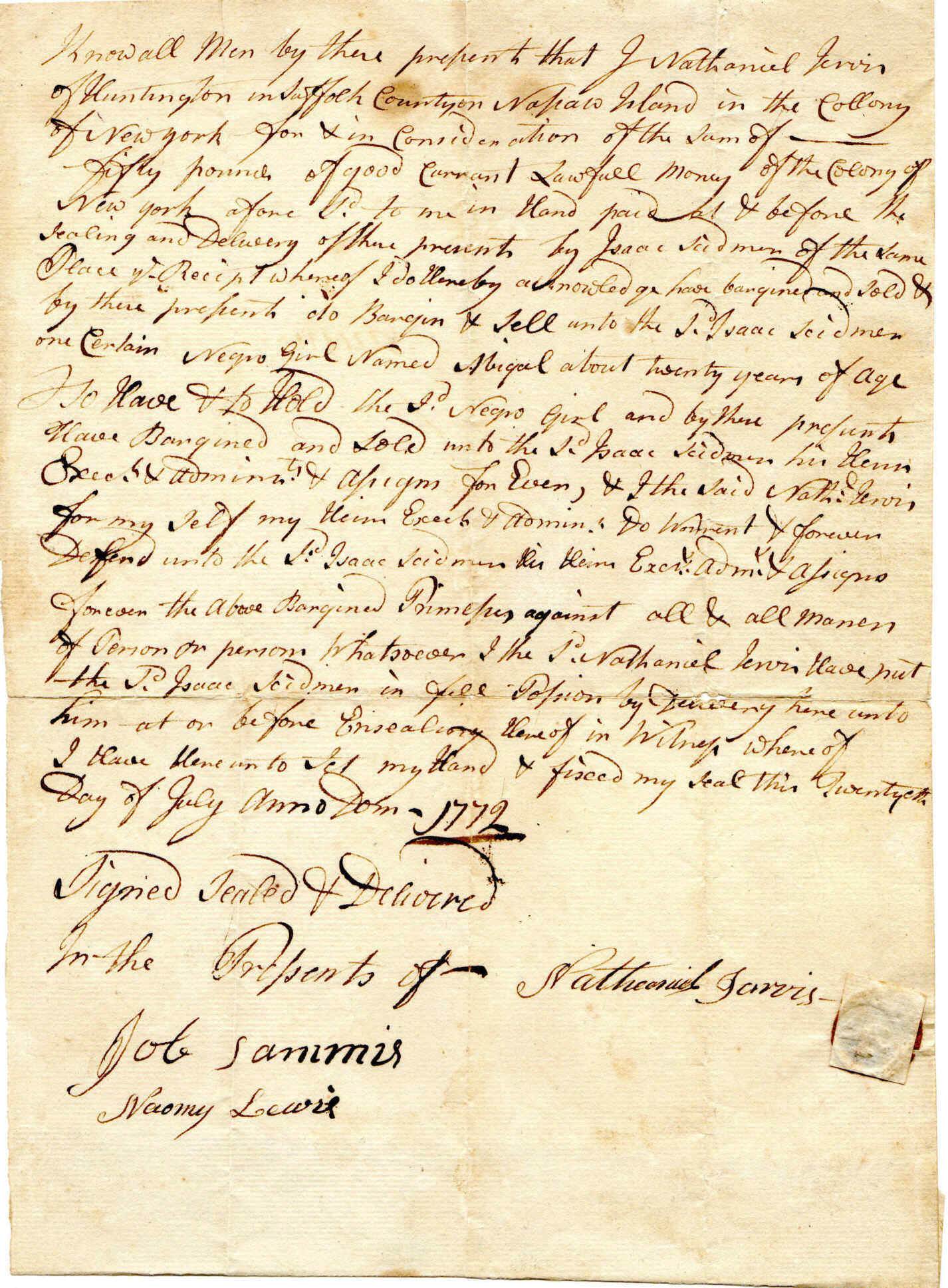
| 1780, Huntington, Long Island, British Army orders eBay Image 1780, Huntington, Long Island, British Army orders: Sold Date: 10/31/2007 Channel: Online Auction Source: eBay |
| This item is a wonderful,original document dated 1780, Huntington, Long Island; where Colonel Howlett (actuually Colonel Richard Hewlett, a Tory who later fled to Nova Scotia) has given orders to Captain Carroll to order all sergeants and corporals to furnish five sleds with ropes and to go to Moreiches and point out whose sleds and horses must go...signed by Lt. Fleet orders to Isaac Scidmore. Document is 4x6, folds,else in overall fine shape; worthy of the finest collections Isaac Scidmore, though a Patriot, signed an oath of allegiance to British Governor Tryon shortly after the battle of Long Island. He was a corporal in the British Militia, yet a patriot at heart After the disastrous "Battle of Long Island" the American troops were forced into retreat from the Island for the remainder of the War and many Long Island units simply ceased to be - and now retribution was on the "Whigs" by the British and Loyalists for their earlier indignties and perscecutions. New York City became the British headquarters and it was Long Island's fate to house, feed and maintain the army for the remainder of the war. To the Carman family, as all the families of the Island, it meant families would devide against themselves, much as it would happen 85 years later in the American Civil War. The British did not depart Long Island until 1783, marking seven years of occupation. Long Island began a period of change it would never recover from. Not only families but entire communities were split. During the British occupation of Long Island virtually all churches, except the 'official' Church of England, were closed by the British order. Several cemeteries found their grave markers being pulled up and used cooking fire hearths for the British troops "Those who remained on the Island were compelled to swear allegiance to King George. Some did this with good grace, and some of necessity. To none was it so distasteful as we are disposed to imagine. . Many have asked for clarification. Here's one of the companies of Militia under Colonel William Floyd, before he fled from the British: The people of Long Island responded to the call of the Provincial Congress, asking them to organize in military bodies as early as the inhabitants of the other counties, and below are given the earlier organizations. The fortunes of war severing the connection between the island and the main land, these organizations could not be kept up, hence the list of Long Island officers is necessarily small. The Council of Appointments made no appointments for Long Island until 1784. SUFFOLK COUNTY. .... First Regiment...... Col. Wm. Floyd, of St. George's Manor, vice Platt Conkling, who declined.......... Lieut. Col. Dr. Gilbert Potter, of Huntington............. 1st Major Nathan Woodhull, of Brookhaven........... Capt. Timothy Carll.......... 1st Lieut. Gilbert Fleet........... 2d Lieut. Joel Scudder............. Ensign Nath'l Buffet, Jun'r. ........Corp. Isaac Scidmore Colonel William Floyd ( signer of the Declaration of Independence) suffered severely, like many of his fellow patriots, the destructive effect of the war upon his property and the serious inconveniences put upon his family. While Floyd was at Philadelphia, the American troops evacuated Long Island and it was taken possession of by the British army. His family was obliged to flee for safety to Connecticut. His house was occupied by a company of British horsemen, which made it their meeting place during the remainder of the war. For nearly seven years, Floyd and his family were refugees from their home and he was often in great straits, having nothing but his pay as a delegate in congress to support himself and his family. The requirements of the British pressed heavily on all classes, many of the most pronounced Patriots abandoned their property and sought refuge in Connecticut or service in the Continental army; the oath of allegiance was ordered to be taken by all of the adult male population, and the records show that 549 of the dwellers in Huntington gave this evidence of their lip loyalty at least to the dominant cause. Those who had belonged to the local militia were compelled to do military duty, such as guard mounting, etc. As the period of the occupation progressed and the township was overrun by the Loyalist regiments - the scum of the population in the large cities - robbery and wanton destruction of property became the rule and all pretence of any law except that of might and the drum-head was abandoned. The people were openly accused of being rebels, even those who had taken the oath being regarded with suspicion, and those who escaped that declarataion of lip loyalty were few, for Governor Tryon had swept Suffolk county as with a dragnet and forced the acceptance of the declaration with the alternative of an enforced trip to Connecticut. |
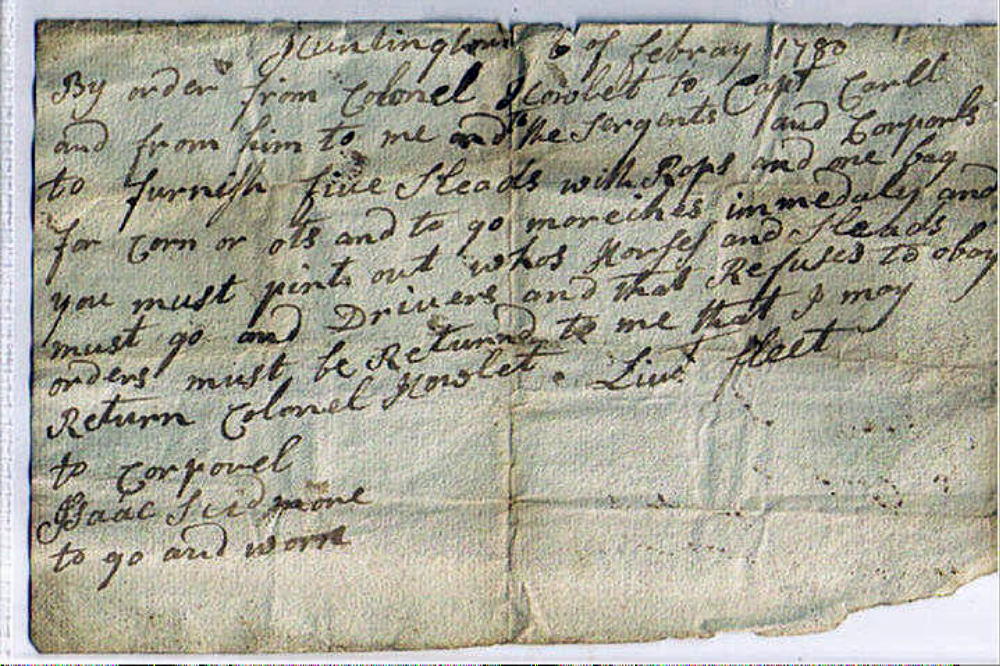
| 1779, Huntington, Long Island, Orders for His Majesties Army, signed This is a wonderful original order, dated Huntington, January 8th, 1779,where Captain Timothy Carrl has directed Corporal Isaac Scidmore to gather all the ox teams and waggons belonging within the district..to appear at Lloyd's Neck...to draw wood for the use of His Majesties garrisons at New York and Rhode Island...if people neglect to come they will send a file of soldiers to fetch them....Captain Timothy Carrl. Orders are 6x8, ink lightened, else a very scarce order during the British occupation of Long Island. Many of the local militia, while loyal to the patriot cause, were ordered by the British to do military duty, as Long Island was still under the King's rule. Of all the Carll family, Timothy Carrl, seems to be remembered the most for his actions while under British occupation. As the Captain of the Dicks Hills Militia he was forced to take his men, with shovels and picks, and clear the Huntington town cemetery for the construction of a new British fort named Golgotha that was to be built on the sight. Refusing the demand to desecrate the graveyard, Captain Carll was finally forced to take his men and do the job even many British soldiers seemed reluctant to get involved in. To add to the insult of having destroyed the local burial ground, the men were then made to take the old tombstones and build fireplaces with them for the soldiers, or even use them as front steps leading to the entranceways of some of the buildings located in the new fort. When the work was finally done, in just under two weeks, never a day passed that the soldiers were not reminded of what they had done. All the bread that was made in the tombstone ovens came out with peoples names baked into the bottoms of the loafs from the headstones. Itís said that many of the British soldiers were not amused by this end result. Isaac Skidmore's name occurs in connection with the Revolutionary period in certain bills which he presented, namely : In 1779, a bill of 11 pounds and 4 shillings "for 14 days with ox team, carting forage for General Leland." On April 25, 1779, a bill of 2 pounds and 5 shillings for "one day's rations for thirteen men, and forage for six horses belonging to the Queen's Rangers." |
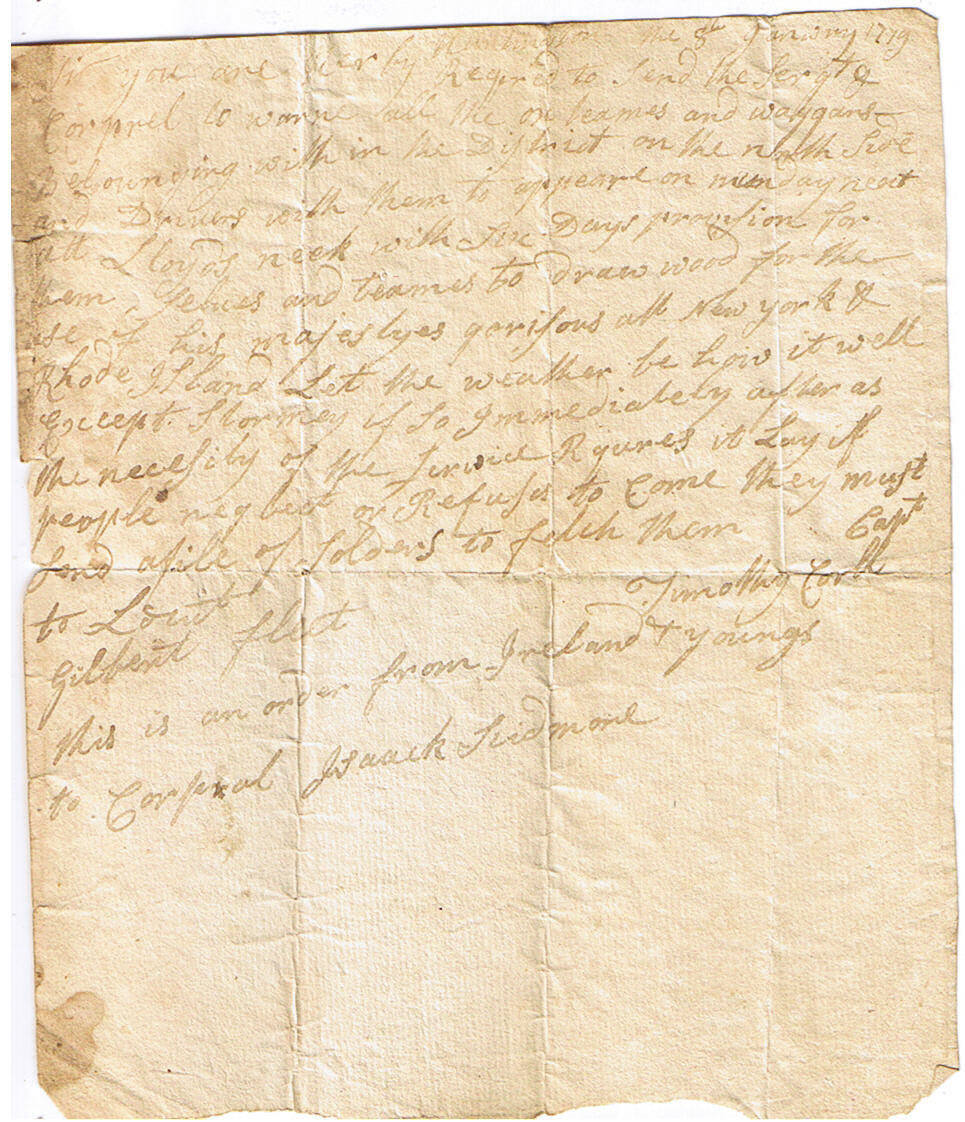
| This item is a wonderful,original document dated July 17th 1780 a pass allowing the Sloop Sea Flower, owned by Isaac Skidmore to deliver such goods as salt, pepper, tobacco and rum....signed by Lambert Moore as British Deputy Superintendant of New York Harbor.....6x7, folds, possible marks left from two small nails??; other traces on back, though very light. Overall a fine and scarce document from the Battle of Long Island Though Isaac Skidmore was a patriot, he was a registered member of the local militia. The militia had been organized before the Revolutionary War. The British had possession of Long Island for 7 full years of the war and never relinquished their ownership of the locals. Many of the militia had to take an oath to King George III during this occupation to show their loyalty was with the King. Many, such as Issac Skidmore, took the oath only to save their property and belongings...failure to take the oath would have meant that the British would confiscate all their belongings.The Skidmore family were patriots and after the long standing occupation of the British, would continue to occupy the family farms on Huntington, Long Island for well over 150 years... |
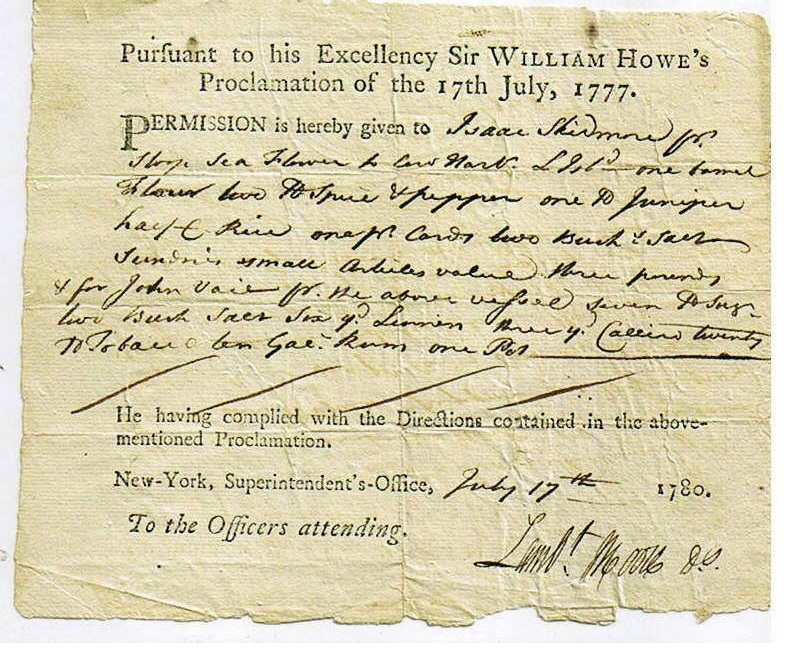
| This item is a wonderful, original document dated 1786, Isaac Scidmore's retained copy of his sale of a Negro Boy named Jack to Aaron Smith for the sum of 25 pounds. In the hand of Isaac Scidmore, unsigned, 7x8, folds, else in good condition. Isaac Scidmore (Skidmore) b. Abt 1735, Huntington, Suffolk Co., New York , d. Bef 21 Nov 1816, Huntington, Suffolk Co., New York (Age ~ 81 years) . |
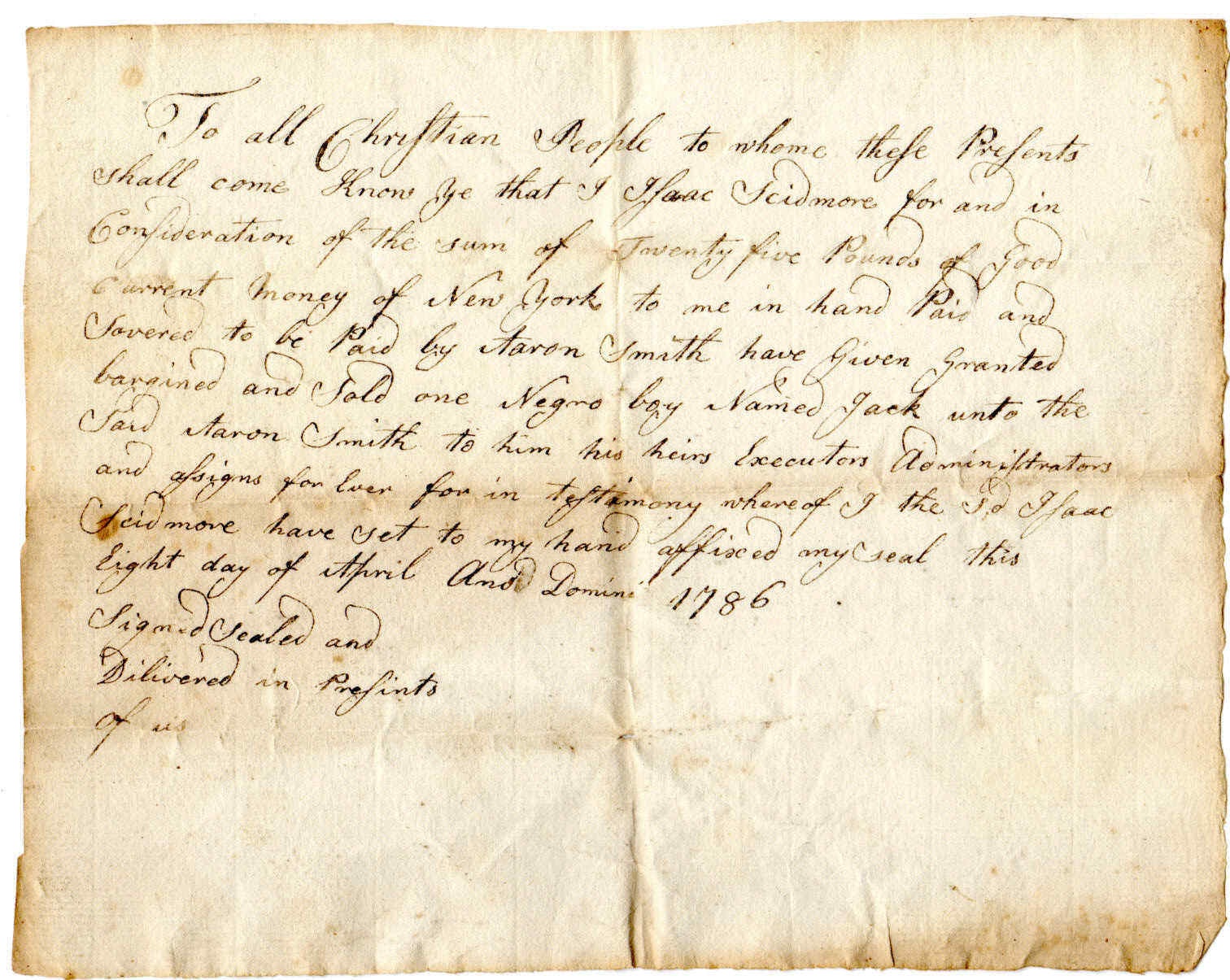
| This is a wonderful, original document dated 1772, Huntington, New York; where Joseph Scidmore has granted to his son Issac Scidmore his servant woman named Cate, with two of her children, Absalom and Tury to use as he sees fit. Signed by Joseph Scidmore, John Stratton and Ebenezer Smith. Document is 8x12, folds, minor age toning, else in fine condition. New York had had the largest colonial slave population north of Maryland. From about 2,000 in 1698, the number of the colony's black slaves swelled to more than 9,000 adults by 1746 and 13,000 by 1756. Between 1732 and 1754, black slaves accounted for more than 35 percent of the total immigration through the port of New York. And that doesn't count the many illegal cargoes of Africans unloaded all along the convoluted coast of Long Island to avoid the tariff duties on slaves. In 1756, slaves made up about 25 percent of the populations of Kings, Queens, Richmond, New York, and Westchester counties. Free blacks lived in New York at risk of enslavement. The colonial courts ruled that if a white person claimed his black employee was a slave, the burden was on the black person to prove he was not. Blacks on the street who could give no plausible account of their movements or proof of their freedom often were picked up by the authorities and jailed on suspicion of being runaway slaves. Local authorities had all but unlimited power in such cases Slavery existed in Huntington,Long Island until the beginning of the nineteenth century. Farmers relied on slave labor for help in the fields and it was a mark of status to have black slaves as domestic servants, but rarely did a person own more than a few slaves. For example, according to a 1755 census, t were 81 slaves belonging to 35 families in Huntington. Unlike the South, the economy was not heavily dependent on slave labor. The New York State Legislature passed an act in 1799 allowing for the gradual abolition of slavery. Bob Vornlocker Note - This same Cate is given to Joseph's mother in his father' John's will. This document was written about six months after Joseph's will. In an earlier will he had left Cate to his wife. . |
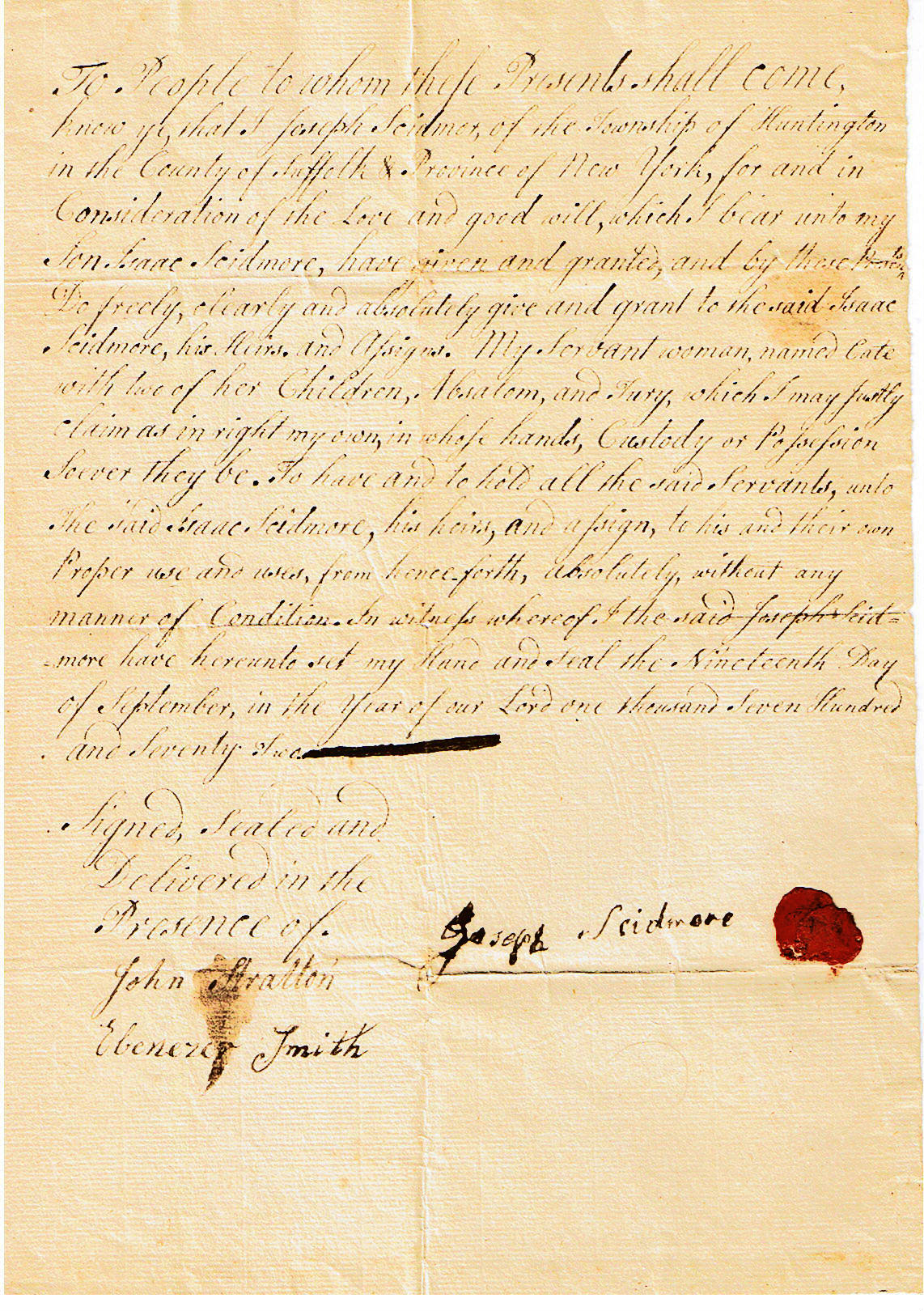
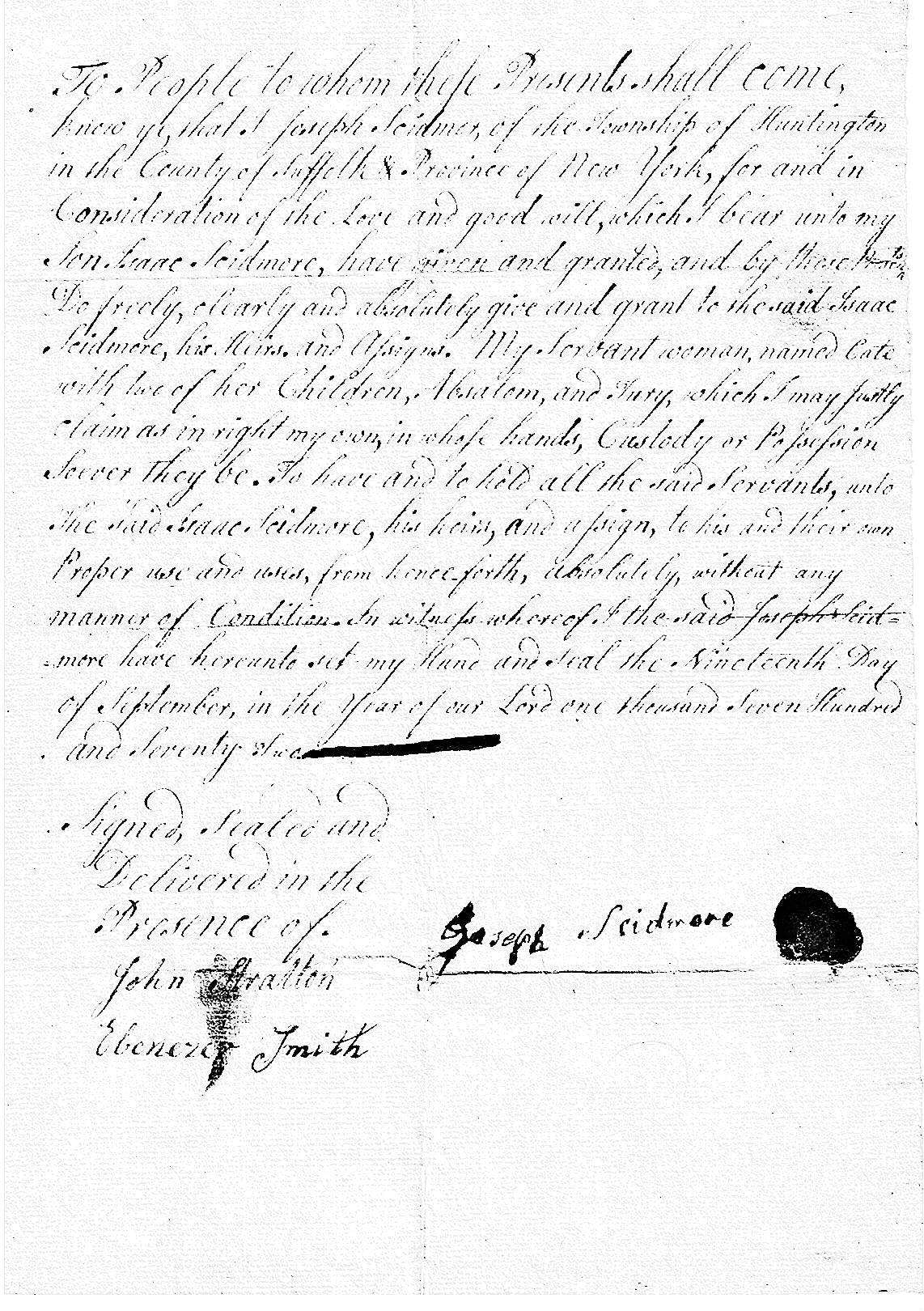
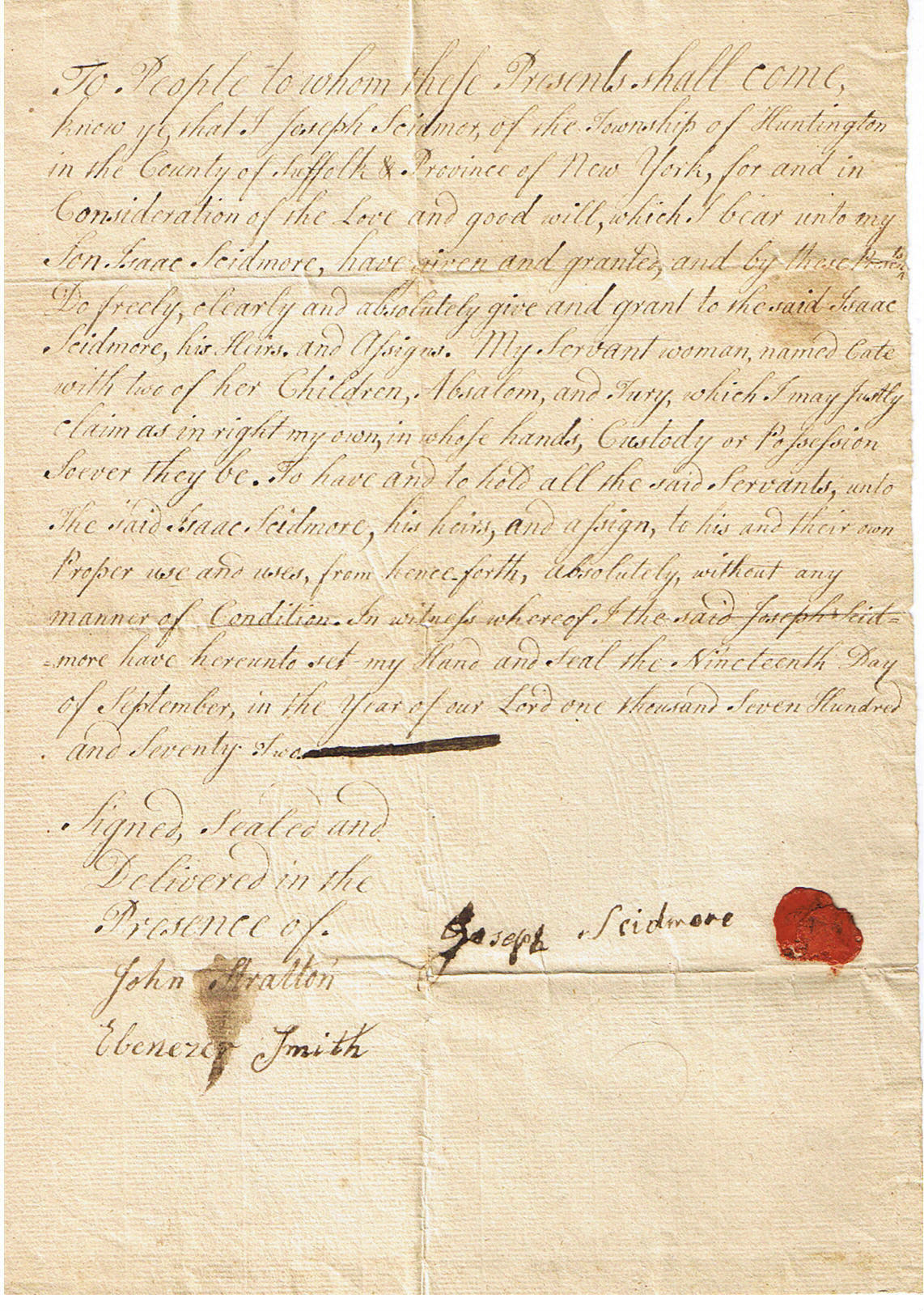
| This is a wonderful original order, dated Huntington Hills, January 20th, 1779,where Captain Timothy Carrl has directed Corporal Isaac Scidmore to gather all the ox teams and waggons belonging within the district..to appear at Lloyd's Neck...to draw wood for the use as required....signed by Captain Timothy Carrl. Document is 6x8, toned, else in overall good condition. A very scarce order during the British occupation of Long Island. Many of the local militia, while loyal to the patriot cause, were ordered by the British to do military duty, as Long Island was still under the King's rule. Of all the Carll family, Timothy Carrl, seems to be remembered the most for his actions while under British occupation. As the Captain of the Dicks Hills Militia he was forced to take his men, with shovels and picks, and clear the Huntington town cemetery for the construction of a new British fort named Golgotha that was to be built on the sight. Refusing the demand to desecrate the graveyard, Captain Carll was finally forced to take his men and do the job even many British soldiers seemed reluctant to get involved in. To add to the insult of having destroyed the local burial ground, the men were then made to take the old tombstones and build fireplaces with them for the soldiers, or even use them as front steps leading to the entranceways of some of the buildings located in the new fort. When the work was finally done, in just under two weeks, never a day passed that the soldiers were not reminded of what they had done. All the bread that was made in the tombstone ovens came out with peoples names baked into the bottoms of the loafs from the headstones. Itís said that many of the British soldiers were not amused by this end result. |
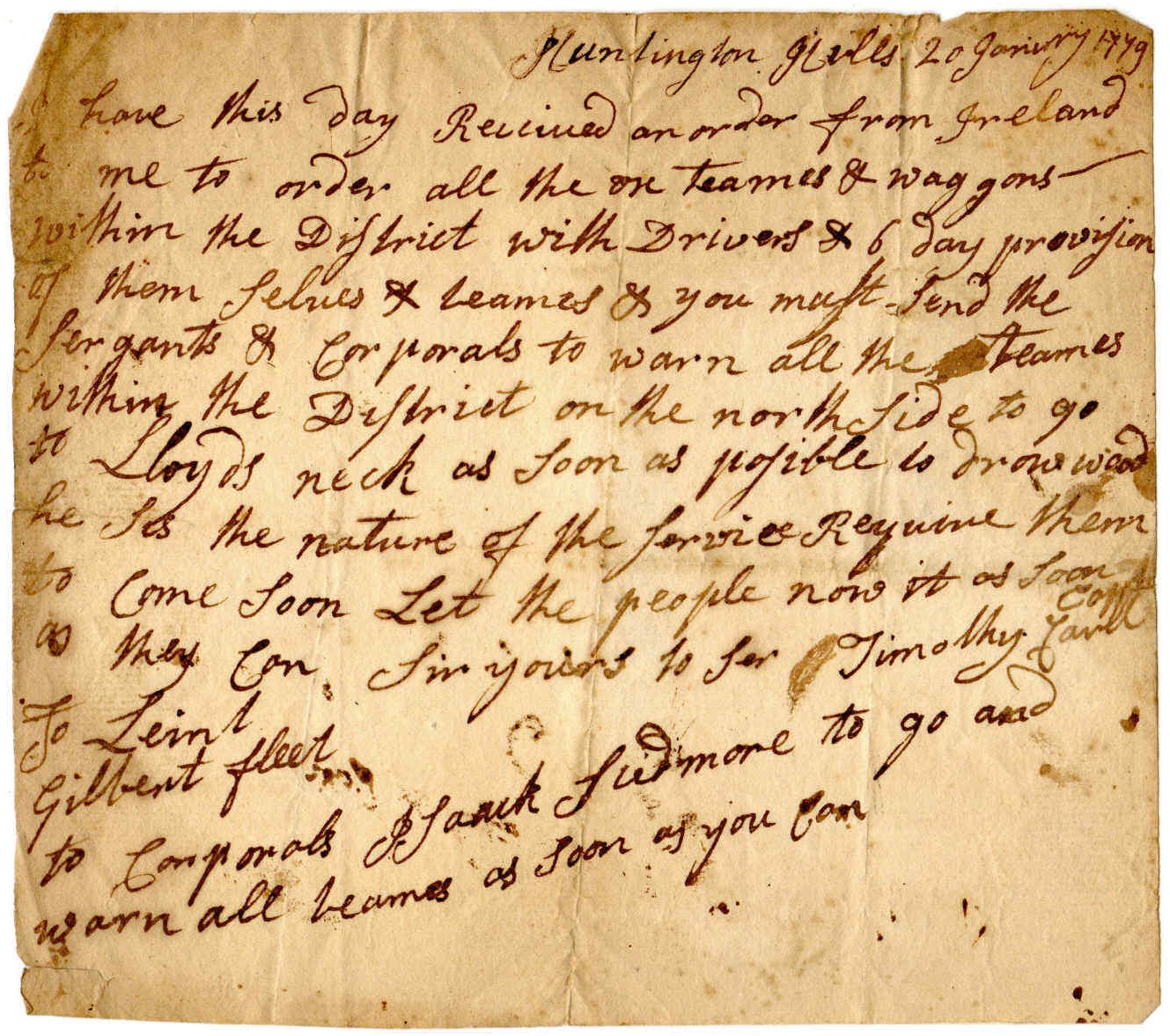
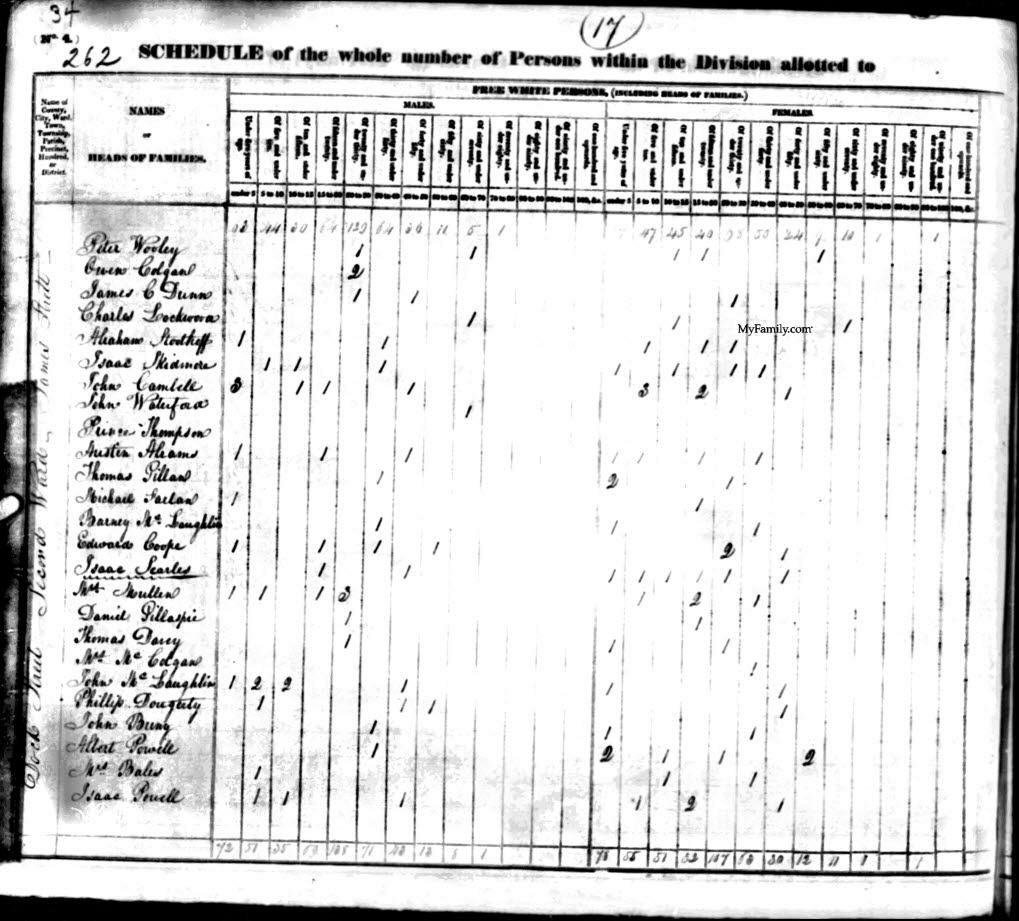
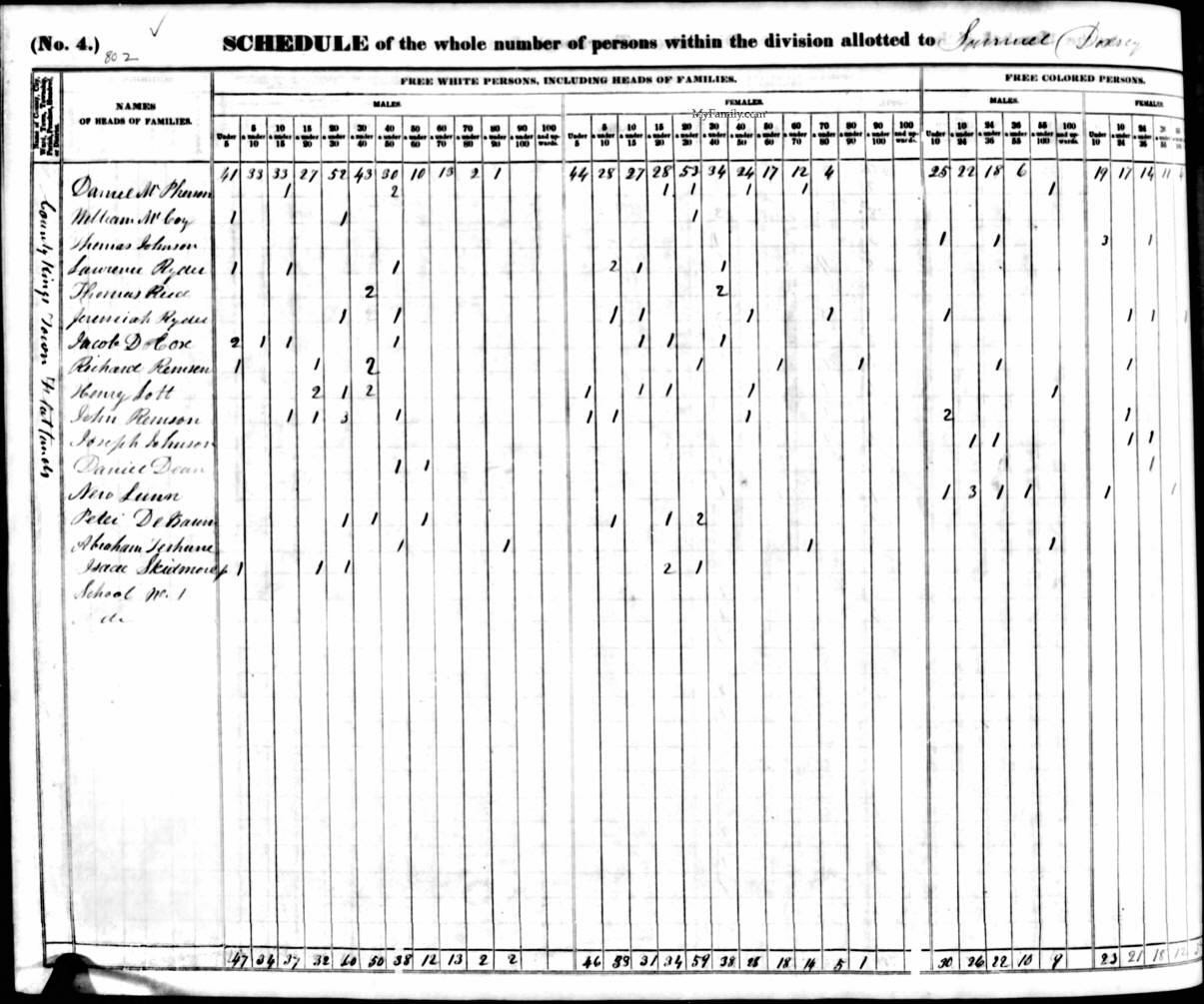
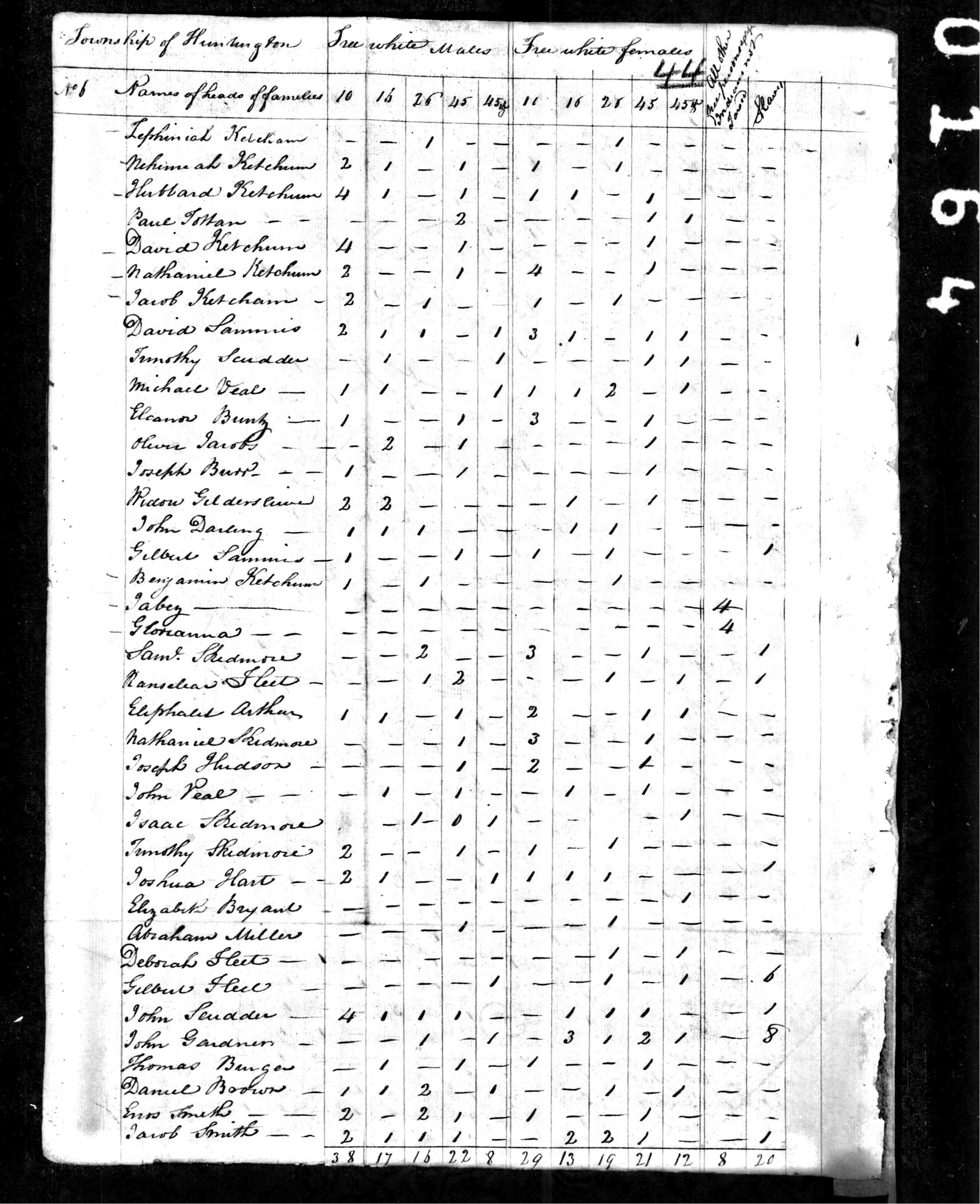
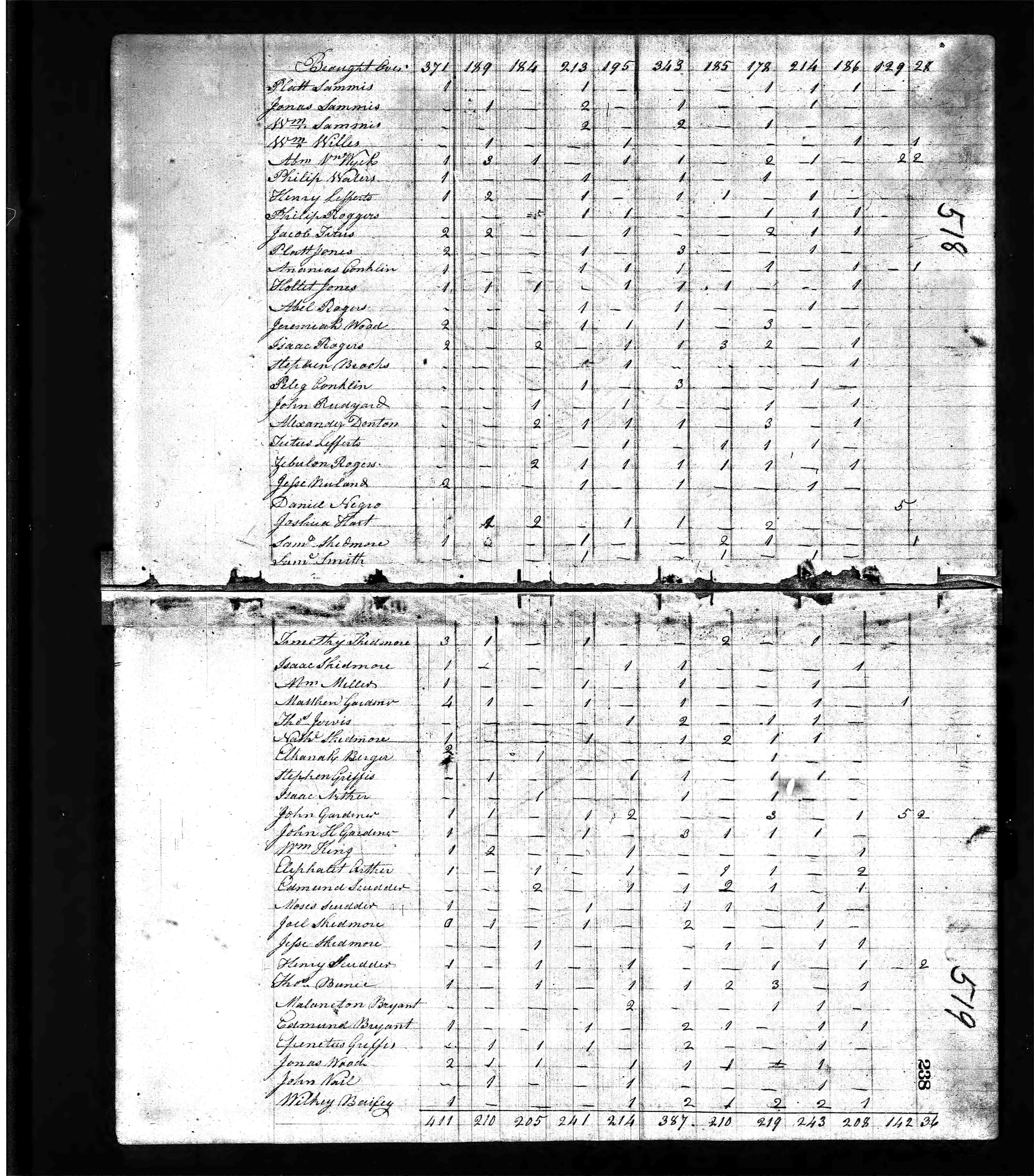
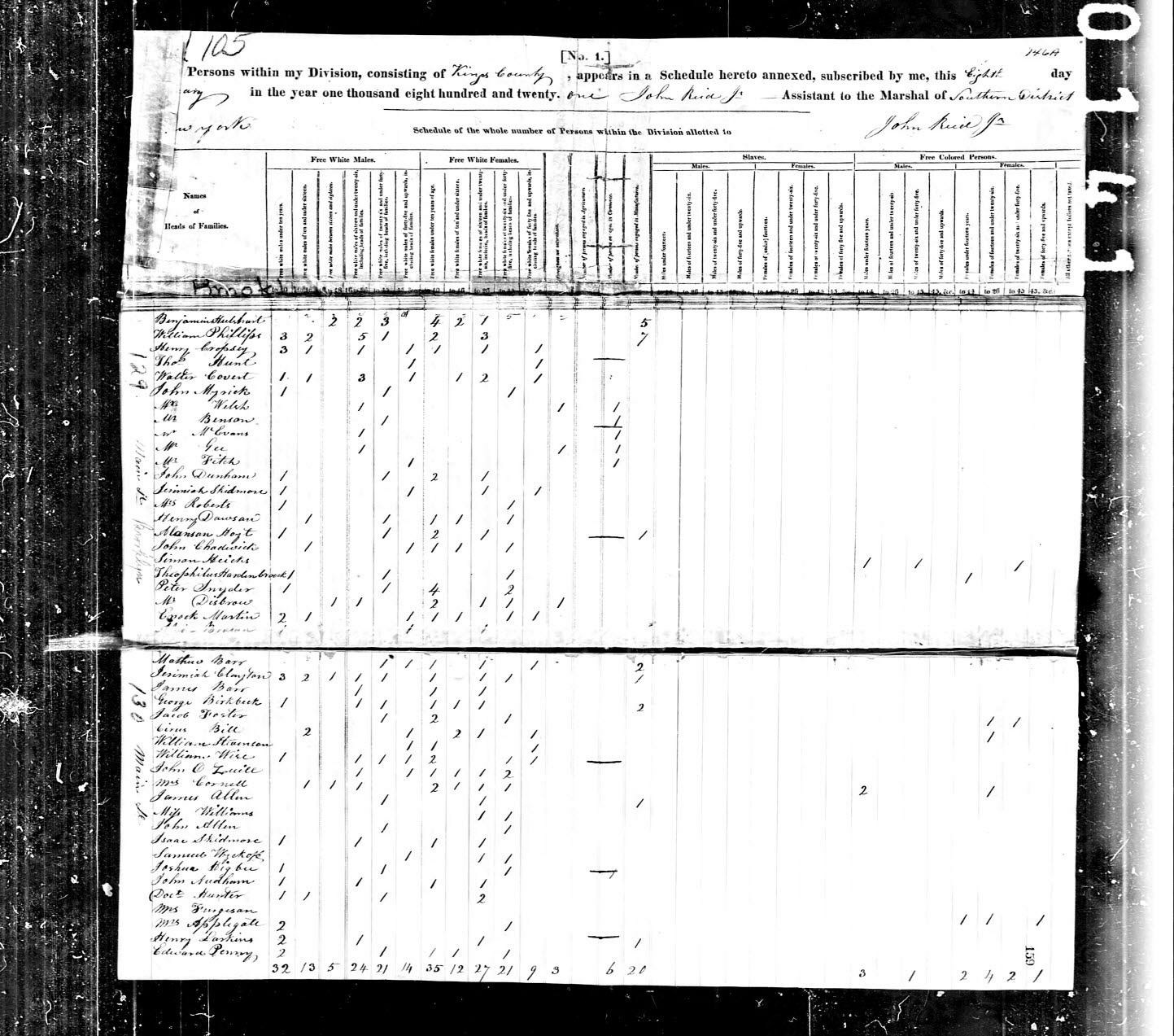
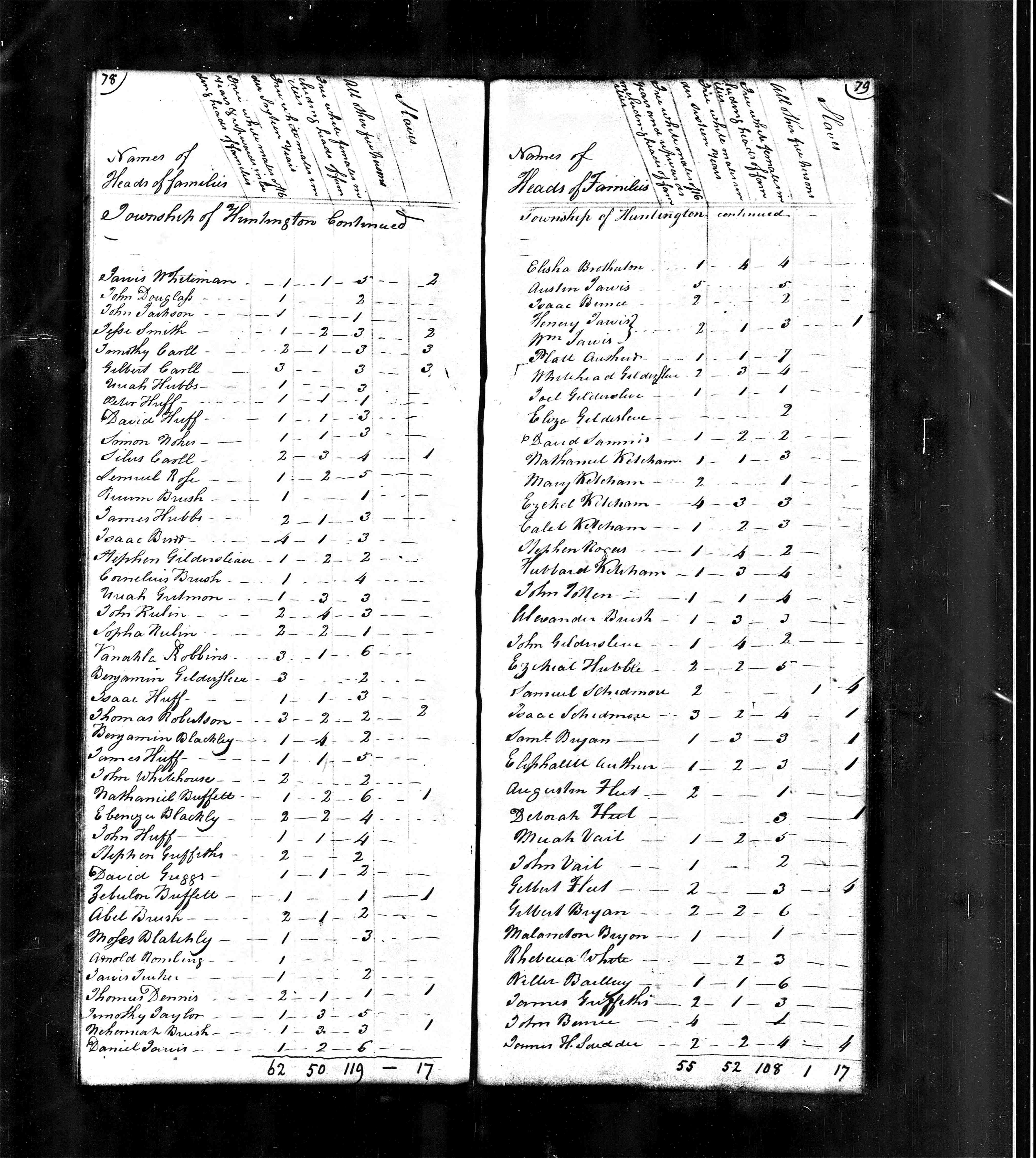
These pages have been generated by the software Oxy-Gen version 1.39c, on 21/02/2016. You can download it here.